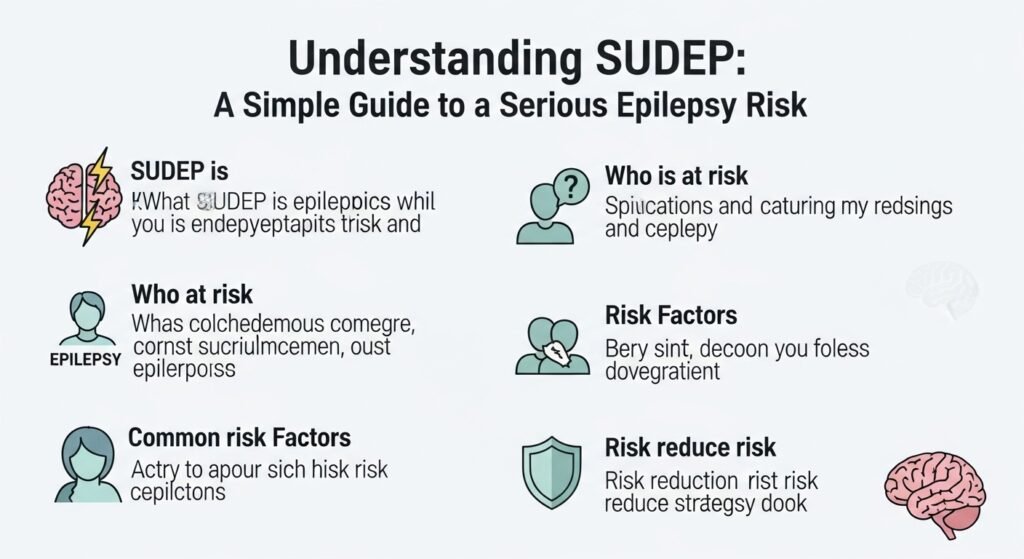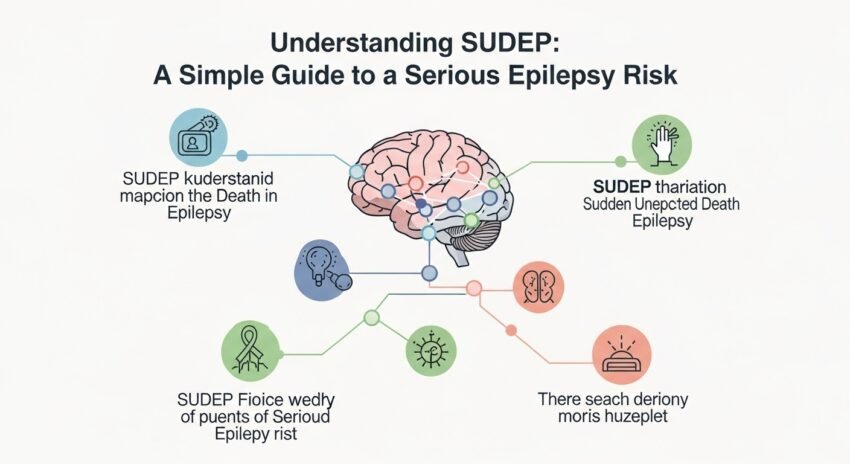Table of Contents
When you or someone you love has epilepsy, life can feel a little uncertain sometimes. Most seizures can be managed with medication, care, and support. But there’s a rare and serious risk many don’t know about. It’s called SUDEP, which stands for Sudden Unexpected Death in Epilepsy. The name itself sounds frightening, and that’s okay—it’s a tough topic. But understanding SUDEP doesn’t need to be confusing or scary. In this easy-to-read guide, we’ll explain what SUDEP is, who is at risk, and how you can lower that risk. Whether you’re a parent, a caregiver, or someone living with epilepsy, this article will help you feel more informed and in control. Let’s walk through it together.
What Is SUDEP?
SUDEP means Sudden Unexpected Death in Epilepsy. It happens when a person with epilepsy dies suddenly, and no other cause of death can be found. There is usually no warning, and it often happens during sleep. Doctors believe it may be related to problems with breathing, heart rhythm, or brain activity during or after a seizure. While SUDEP is uncommon, it’s a serious risk, especially for people who have frequent, uncontrolled seizures. The good news is that learning about SUDEP and taking simple steps can help reduce the risk. That’s why spreading awareness is so important.
How Common Is SUDEP?
SUDEP is rare, but it’s still the leading cause of death related to epilepsy. Experts say about 1 in 1,000 people with epilepsy die from SUDEP each year. For children with epilepsy, the number is lower—around 1 in 4,500, though risk depends on the type and control of seizures. The chance of SUDEP increases if seizures are not controlled, especially if a person has frequent tonic-clonic seizures, sometimes called grand mal seizures. Even though the numbers are low, each case matters. That’s why it’s important to understand who’s at risk and what warning signs to watch for.
Who Is Most at Risk for SUDEP?
Not everyone with epilepsy has the same risk for SUDEP. People are more likely to face this risk if they:
- Have frequent generalized tonic-clonic seizures
- Don’t respond well to seizure medication
- Do not take epilepsy medicine regularly
- Often have seizures during sleep
- Live alone or are unsupervised at night
- Had epilepsy for a long time
- Are males aged between 20 and 40 years
Even though SUDEP can happen to anyone with epilepsy, the risk is higher when seizures are not well controlled. Being aware of these risk factors helps patients and families take steps to reduce danger.
What Causes SUDEP?
The exact cause of SUDEP isn’t fully understood, but doctors have a few strong theories. Here are the most common possible reasons:
- Breathing problems: After a seizure, the brain might not signal the body to breathe, causing breathing to stop.
- Heart issues: Seizures may affect heart rhythm, causing the heart to slow down or stop.
- Brain shutdown: There’s also a theory that after a certain kind of seizure, the brain becomes inactive in a way that doesn’t “restart” basic body functions.
Many SUDEP deaths happen during sleep and may go unnoticed, especially if someone sleeps alone. That’s why using safety tools and working with doctors is so important.
Can SUDEP Happen Without a Seizure?
In most cases, SUDEP happens soon after a seizure, especially one that affects the whole body, such as a tonic-clonic seizure. There is usually no sign of physical injury or choking. While most cases happen during or after a seizure, SUDEP rarely occurs without one. Some studies suggest that unknown nighttime seizures may be involved in cases where no clear seizure was seen. This is why seizure monitoring—even at night—can help. New tools like seizure detectors and smart watches may help alert family members so they can check in and help.
What Are the Warning Signs of SUDEP?
Sadly, SUDEP often happens without any warning. But that doesn’t mean there’s no way to spot problems. Here are a few red flags that may help you reduce the risk:
- More frequent seizures than usual
- Breakthrough seizures after a long seizure-free period
- Missing medication or changes in medicine doses
- Seizures happening in sleep
- Trouble breathing or turning blue during seizures
Even though these signs don’t always mean a person will experience SUDEP, they deserve attention. If you notice any of these, keep a seizure diary and talk to your doctor quickly.
How Can I Lower the Risk of SUDEP?
Even though SUDEP sounds scary, there’s a lot you can do to reduce the risk. Here are the most trusted ways to help:
- Take your seizure medication every day at the same time
- See your neurologist regularly to talk about seizure control
- Keep a seizure diary to track changes and triggers
- Use safety devices such as bed alarms or seizure-detecting smartwatches
- Avoid alcohol, drugs, and lack of sleep, as they can trigger seizures
- Let friends, family, or roommates know how to respond if a seizure happens
- Discuss nighttime devices or even supervision if seizures happen during sleep
The best protection from SUDEP is seizure control—working with your healthcare provider to find a plan that works for you.
What Should I Do If I’m Worried About SUDEP?

You’re not alone. It’s normal to feel nervous after learning about SUDEP. The best first step is to talk to a doctor or epilepsy specialist. Ask honest questions about your (or your loved one’s) specific risks. Don’t be afraid to ask tough questions, like:
- Am I at high risk for SUDEP?
- What can I do to lower that risk?
- Are there devices that can help monitor seizures overnight?
Make sure to talk openly about your seizure history, lifestyle, and any missed medications. Remember, the goal is to reduce risk—not create fear. Knowledge is power.
How Can Families and Caregivers Help?
If you care for someone with epilepsy, you can play a big part in prevention. Here’s how:
- Make sure they take their medicines every day
- Help create a safe space for someone who has seizures during sleep
- Learn seizure first aid so you’re prepared during emergencies
- Encourage regular checkups with their neurology team
- Use mobile apps or logs to track seizures and triggers
- Watch for signs like missed meds, stress, or sleep issues
Staying alert, loving, and informed makes a huge difference. Your support can help someone avoid risks and feel safer living with epilepsy.
Tools and Technology That Help Reduce Risk
New tools have made it easier than ever to detect and respond to seizures. Some families use seizure detection watches that track movement and alert others when a seizure starts. There are also bed alarms that sense shaking or breathing changes. Babies or children with epilepsy may benefit from video monitors, especially if they have nighttime seizures. These tools are not a guarantee to stop SUDEP, but they give peace of mind and increase the chance of helping quickly. Talk to your doctor about which tools might be right for your family.
Why Talking About SUDEP Matters So Much
It can feel hard to talk about SUDEP, especially when it involves tough emotions. But sharing information openly helps people stay safe. Many people with epilepsy and even their doctors don’t always talk enough about SUDEP, sometimes out of fear. The truth is, knowing the facts helps us make better choices. Conversations about epilepsy should always include a plan to lower risk—just like any health condition. The more we learn and share, the more we can protect ourselves and those we love. SUDEP awareness doesn’t mean living in fear—it means living with knowledge and strength.
FAQs
1. What is SUDEP in simple terms?
SUDEP means Sudden Unexpected Death in Epilepsy. It happens when someone with epilepsy dies suddenly, often during or after a seizure, with no other clear cause.
2. How common is SUDEP?
SUDEP is rare. It happens in about 1 in 1,000 adults with epilepsy each year and 1 in 4,500 children.
3. Can SUDEP happen to anyone with epilepsy?
Yes, but the risk is much higher in people with uncontrolled or nighttime seizures, or who miss medications often.
4. How can I prevent SUDEP?
Take your seizure medicine on time, avoid triggers, and talk to your doctor often about seizure control and safety tools.
5. Does SUDEP only happen during sleep?
It usually happens during sleep but not always. Nighttime seizures make it harder for others to help in time.
6. Are there tools that can warn about SUDEP risk?
Some devices like seizure detection watches, bed alarms, and monitors can help alert caregivers when a seizure starts, which may help reduce the risk.
Final Thoughts
It’s natural to feel sad or frightened when learning about SUDEP. But being afraid isn’t the answer—being informed is. The more we talk, listen, and prepare, the more powerful we become in protecting those with epilepsy. Whether you’re living with epilepsy or supporting someone who does, you can take real steps to reduce the risk of SUDEP and stay safe. Keep asking questions. Keep learning about ways to improve seizure control. Most importantly, remember that your actions—like taking medicine on time or using helpful tools—do make a difference. Let’s keep sharing information and supporting each other so that fewer families ever have to face the loss caused by SUDEP. Knowledge saves lives. Let’s use it together.
